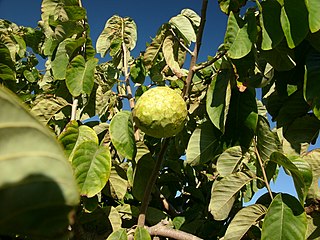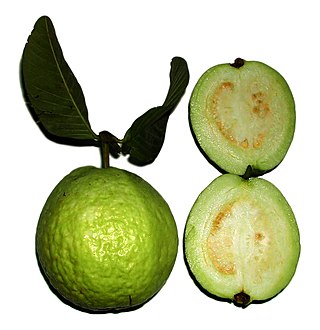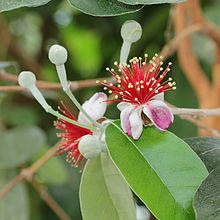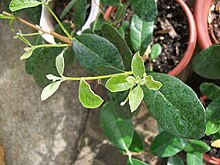
Kiwifruit or Chinese gooseberry is the edible berry of several species of woody vines in the genus Actinidia. The most common cultivar group of kiwifruit is oval, about the size of a large hen's egg: 5–8 centimetres in length and 4.5–5.5 cm in diameter. It has a thin, fuzzy, fibrous, tart but edible light brown skin and light green or golden flesh with rows of tiny, black, edible seeds. The fruit has a soft texture with a sweet and unique flavour.

Breadfruit is a species of flowering tree in the mulberry and jackfruit family (Moraceae) believed to be a domesticated descendant of Artocarpus camansi originating in New Guinea, the Maluku Islands, and the Philippines. It was initially spread to Oceania via the Austronesian expansion. It was further spread to other tropical regions of the world during the Colonial Era. British and French navigators introduced a few Polynesian seedless varieties to Caribbean islands during the late 18th century. Today it is grown in some 90 countries throughout South and Southeast Asia, the Pacific Ocean, the Caribbean, Central America and Africa. Its name is derived from the texture of the moderately ripe fruit when cooked, similar to freshly baked bread and having a potato-like flavor.

A mango is an edible stone fruit produced by the tropical tree Mangifera indica. It originated from the region between northwestern Myanmar, Bangladesh, and northeastern India. M. indica has been cultivated in South and Southeast Asia since ancient times resulting in two types of modern mango cultivars: the "Indian type" and the "Southeast Asian type". Other species in the genus Mangifera also produce edible fruits that are also called "mangoes", the majority of which are found in the Malesian ecoregion.

Rambutan is a medium-sized tropical tree in the family Sapindaceae. The name also refers to the edible fruit produced by this tree. The rambutan is native to Southeast Asia. It is closely related to several other edible tropical fruits, including the lychee, longan, pulasan, and quenepa.

Prunus cerasus is a species of Prunus in the subgenus Cerasus (cherries), native to much of Europe, North Africa and West Asia. It is closely related to the sweet cherry, but has a fruit that is more acidic. Its sour pulp is edible.

Guava is a common tropical fruit cultivated in many tropical and subtropical regions. The common guava Psidium guajava is a small tree in the myrtle family (Myrtaceae), native to Mexico, Central America, the Caribbean and northern South America. The name guava is also given to some other species in the genus Psidium such as strawberry guava and to the pineapple guava, Feijoa sellowiana. In 2019, 55 million tonnes of guavas were produced worldwide, led by India with 45% of the total. Botanically, guavas are berries.

Passiflora edulis, commonly known as passion fruit, is a vine species of passion flower native to southern Brazil and Peru. It is cultivated commercially in tropical and subtropical areas for its sweet, seedy fruit. The fruit is a pepo, a type of berry, round to oval, either yellow or dark purple at maturity, with a soft to firm, juicy interior filled with numerous seeds. The fruit is both eaten and juiced, with the juice often added to other fruit juices to enhance aroma.

The jackfruit is the fruit of jack treeArtocarpus heterophyllus, a species of tree in the fig, mulberry, and breadfruit family (Moraceae). The jackfruit is the largest tree fruit, reaching as much as 55 kg in weight, 90 cm in length, and 50 cm in diameter. A mature jackfruit tree produces some 200 fruits per year, with older trees bearing up to 500 fruits in a year. The jackfruit is a multiple fruit composed of hundreds to thousands of individual flowers, and the fleshy petals of the unripe fruit are eaten.

The cherimoya, also spelled chirimoya and called chirimuya by the Inca people, is a species of edible fruit-bearing plant in the genus Annona, from the family Annonaceae, which includes the closely related sweetsop and soursop. The plant has long been believed to be native to Ecuador and Peru, with cultivation practised in the Andes and Central America, although a recent hypothesis postulates Central America as the origin instead, because many of the plant's wild relatives occur in this area.

The tamarillo is a small tree or shrub in the flowering plant family Solanaceae. It is best known as the species that bears the tamarillo, an egg-shaped edible fruit. It is also known as the tree tomato, tomate de árbol, tomate andino, tomate serrano, blood fruit, poor man's tomatoe, tomate de yuca, tomate de españa, sachatomate, berenjena, chilto and tamamoro in South America, tyamtar, rambheda or rukh tamatar in Nepal, and terong Belanda in Indonesia. It is popular globally, especially in Peru, Colombia, New Zealand, Ecuador, Nepal, Rwanda, Burundi, Australia, Bhutan and the United States.

Chrysophyllum cainito is a tropical tree of the family Sapotaceae. It is native to the Isthmus of Panama, where it was domesticated. It has spread to the Greater Antilles and the West Indies and is now grown throughout the tropics, including Southeast Asia. It grows rapidly and reaches 20 meters in height.

Annona squamosa is a small, well-branched tree or shrub from the family Annonaceae that bears edible fruits called sugar apples or sweetsops. It tolerates a tropical lowland climate better than its relatives Annona reticulata and Annona cherimola helping make it the most widely cultivated of these species. Annona squamosa is a small, semi-(or late) deciduous, much-branched shrub or small tree 3 to 8 metres tall similar to soursop. It is a native of tropical climate in the Americas and West Indies, and Spanish traders aboard the Manila galleons docking in the Philippines brought it to Asia.

Pandanus tectorius is a species of Pandanus (screwpine) that is native to Malesia, Papuasia, eastern Australia, and the Pacific Islands. It grows in the coastal lowlands typically near the edge of the ocean. Common names in English include thatch screwpine, Tahitian screwpine, hala tree and pandanus. The fruit is edible and sometimes known as hala fruit.

Diospyros nigra, the black sapote, is a species of persimmon. Common names include chocolate pudding fruit, black soapapple and zapote prieto. The tropical fruit tree is native to Mexico, Central America, and Colombia. The common name sapote refers to any soft, edible fruit. Black sapote is not related to white sapote nor mamey sapote. The genus Diospyros has numerous other fruit bearing tree species in addition to the persimmons and black sapote.

Solanum muricatum is a species of evergreen shrub native to South America and grown for its sweet edible fruit.

Psidium guajava, the common guava, yellow guava, lemon guava, or apple guava is an evergreen shrub or small tree native to the Caribbean, Central America and South America. It is easily pollinated by insects; when cultivated, it is pollinated mainly by the common honey bee, Apis mellifera.

The atemoya, Annona × atemoya, or Annona squamosa × Annona cherimola is a hybrid of two fruits – the sugar-apple and the cherimoya – which are both native to the American tropics. This fruit is popular in Taiwan, where it is known as the "pineapple sugar apple" (鳳梨釋迦), so it is sometimes wrongly believed to be a cross between the sugar-apple and the pineapple. In Cuba it is known as anón, and in Venezuela chirimorinon. In Lebanon, the fruit is called achta. In Tanzania it is called stafeli dogo. In Brazil, the atemoya became popular and in 2011, around 1,200 hectares of atemoia were cultivated in Brazil. In Taiwan, the cultivating area of atemoya was 2,856.46 hectares in 2020, and Taitung County was the major place of cultivating.

The fig is the edible fruit of Ficus carica, a species of small tree in the flowering plant family Moraceae, native to the Mediterranean region, together with western and southern Asia. It has been cultivated since ancient times and is now widely grown throughout the world. Ficus carica is the type species of the genus Ficus, containing over 800 tropical and subtropical plant species.

The 'Ice Cream' mango is a semi-dwarf mango cultivar that originated in Trinidad and Tobago and was later introduced to Florida.

Myrteae is the largest tribe in the plant family Myrtaceae. It includes most of the species of the family that have fleshy fruits.



























